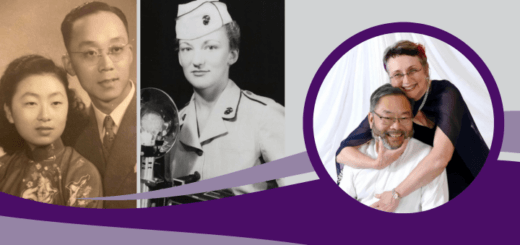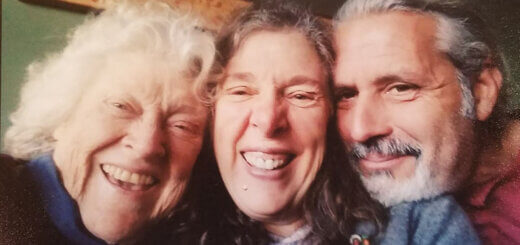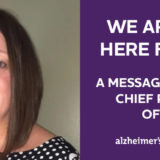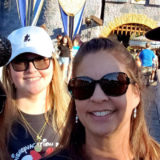Long distance caregiver cares for both parents with Alzheimer’s
Caregiving for a parent with Alzheimer’s can be challenging. It’s even harder when both parents have the disease. Add on the extra stress of being an only child to parents living over 350 miles away: that was Emi Gusukuma’s experience. Emi shares her story of choosing her family over her career and caring for them the best she could from afar.
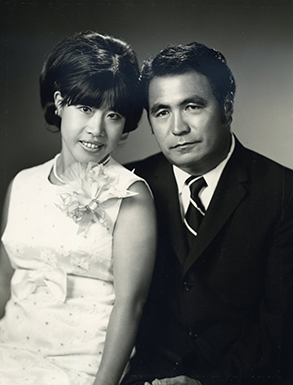
Two parents, one disease
When Emi Gusukuma’s father Seikichi (who went by Gus) was diagnosed with Alzheimer’s in 2006, she had no idea this was the beginning of a 12-year, long distance caregiving journey. Emi’s mother, Yuki, was able to provide the majority of the care until 2013 when she was also diagnosed with Alzheimer’s.
Before Alzheimer’s, Gus was a retired truck driver. “He wore a uniform and drove the red and white truck,” said Emi. “He was a Teamster and worked for Budweiser for 25 years. Dad could fix anything; he was very handy.
“He was also a fantastic vegetable farmer. In the summers our backyard would be transformed. We had five-foot-tall tomato plants, eggplant and squash. You name it, we had it.”
Yuki was a part time housecleaner for a few families, but her passion was teaching at a Japanese school. “She taught calligraphy classes to little kids,” shared Emi. “She could sing and was well known in our family as a fantastic cook. My mom was super crafty and loved to make things.”
Long distance caregiving
Emi lives in Foster City but, at the time, her parents lived in Los Angeles. “I would go home every three to four weeks,” said Emi. “My mom didn’t speak English, so I would go down to help her navigate the healthcare system for my dad.”
Eventually Emi took over the finances for the household as well. “You’re running a household and a half,” said Emi. “I moved all of their bills onto auto pay and wrote all the checks. I still had Dad sign them and I made sure to explain the bills to him, so he was always in the loop. This helped him feel like he had control over his finances.”
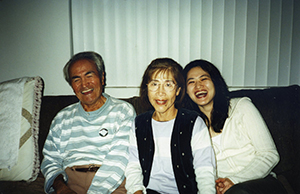
Difficult choices
Emi thought about providing the care herself but knew it would be better for everyone if she continued her work as a lawyer. “It wasn’t feasible for me to quit my job and care for them myself,” said Emi.
“Instead I looked for a small firm that would allow me to work part-time. At the time, I was in the prime of my career, but I needed the flexibility to go home.”
Finding paid caregivers
“We started with part time caregivers for my dad,” said Emi. “After mom was diagnosed, we had to get 24-hour care. It was only affordable because I had my mom sign up for long term care insurance before she got sick.
“That was the best thing I could have done. The premiums weren’t cheap, but it was worth it, and the money went a long way.
“I’m not a trained caregiver. The caregivers I hired were wonderful people and brought something to my parents that I couldn’t.
“When you have dementia, your life can become narrow. Having the different faces of caregivers cycling through the house was good for them.”
Finding Mom a new home
When Gus died in 2017, Emi knew it was time to move her mom up to the Bay Area. “There was a board and care with six rooms run by a Japanese man with a Japanese speaking staff in nearby San Mateo,” said Emi. “We had to wait for a spot to open up, but when it did, Mom moved in after a short period of time in an assisted living facility in Campbell.”
Emi particularly liked this place because they understood her mother’s needs. The staff could relate to Emi’s mom by speaking and singing to her in her native language and making food Yuki liked to eat. Yuki lived there until she died in 2018.

Becoming an advocate
One day, while she was scrolling through Facebook, Emi saw a post about Advocacy Day. As a lawyer with a connection to the disease, she figured she could help, so she signed up.
When she arrived at the event in Sacramento, she was impressed with how organized the Alzheimer’s Association was and how well they trained their volunteers.
“Their social media game is strong,” said Emi. “They make it easy for people to share their story. They give you the statistics and the hashtags you need, which made it really easy for us to create impactful social media posts and feel like we had an important role in the fight against Alzheimer’s.
“The gentleman living with dementia who shared his story was heartbreaking, but I was incredibly moved. You knew you were in a community of people who were going through the same things as you.”
The power of stories
Meeting with legislators (or their staff) is one of the most important parts of Advocacy Day. “We were well received,” said Emi.
“Everyone was respectful and polite. It’s a really positive experience and the Alzheimer’s Association provided us with all the tools we needed to succeed.”
Emi goes on to say, “I think there is something healing about telling your story to other people. When you go into Advocacy Day and tell a staffer about your loved one, they hear first-hand about how Alzheimer’s impacted your life. Stories like that are what make an impact and help get our voices heard.”
Come share your story with your legislator at California State Advocacy Day in Sacramento on February 5, 2020. Register online at tinyurl.com/caadvday2020 by January 17.
Learn more:





